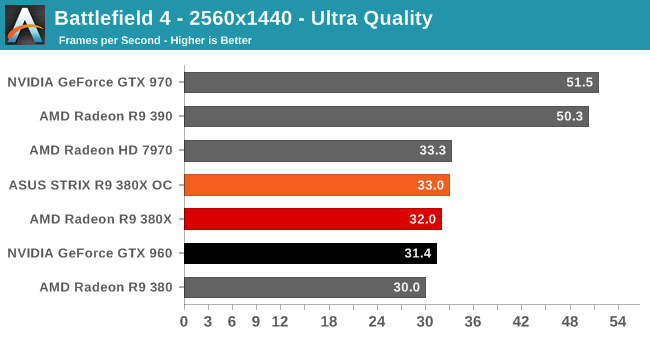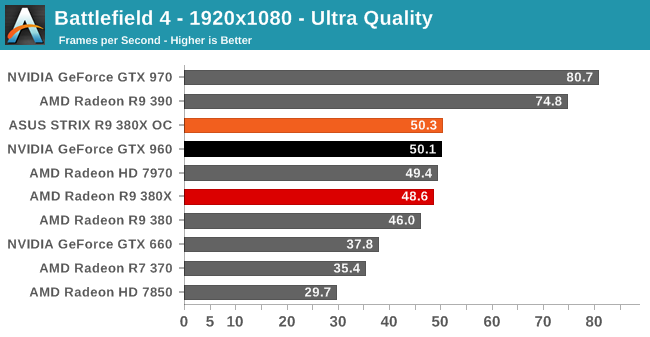The AMD Radeon R9 380X Review, Feat. ASUS STRIX
by Ryan Smith on November 23, 2015 8:30 AM EST- Posted in
- GPUs
- AMD
- Radeon
- Asus
- Radeon 300
Battlefield 4
Kicking off our benchmark suite is Battlefield 4, DICE’s 2013 multiplayer military shooter. After a rocky start, Battlefield 4 has since become a challenging game in its own right and a showcase title for low-level graphics APIs. As these benchmarks are from single player mode, based on our experiences our rule of thumb here is that multiplayer framerates will dip to half our single player framerates, which means a card needs to be able to average at least 60fps if it’s to be able to hold up in multiplayer.


Though not doing poorly, Battlefield 4 has not been a game AMD’s products have excelled at lately. Case in point, at 1080p even the referenced clocked R9 380X can’t unseat the GeForce GTX 960; it takes the ASUS factory overclock to do that. Overall while the 380X is on average 10% faster than the GTX 960, as we’ll see as we work through our games it will not take the top spot in every single game, so this will not be a clean sweep.
Meanwhile Battlefield 4 is a good example of why AMD wishes to focus on 1440p, despite the fact that Tonga is going to come up a bit short in overall performance. As we’ve seen time and time again, AMD’s performance hit with resolution increases is less than NVIDIA’s, so a loss for the R9 380X at 1080p is a win at 1440p. There are a few cases where the R9 380X is fast enough for 1440p, but by and large you’d have to take a quality hit to reach the necessary performance. So unfortunately for AMD this bulk of the focus on the R9 380X is going to be at 1080p.
As for comparisons with past cards, we’ve gone ahead and thrown in the Radeon HD 7850 and the GeForce GTX 660, 2GB cards that launched at $249 and $229 respectively in 2012. Part of AMD’s marketing focus for the R9 380X will be as an upgrade for early 28nm cards, where the R9 380X is a significant step up. Between the greater shader/ROP throughput, greater memory bandwidth, and doubled memory, the R9 380X is around 82% faster than the 7850, which traditionally is around the area where a lot of gamers look for an upgrade.
Finally, at the other end of the spectrum, it’s worth pointing out just how far ahead of the R9 380X the R9 390 and GTX 970 are. In the introduction we called them spoilers, and this is exactly why. They cost more, but the performance advantage of the next step up is quite significant.










101 Comments
View All Comments
CaedenV - Monday, November 23, 2015 - link
Card idle so low now that it does not make much of a difference. Even leaving my 4 year old monster on 24/7 is costing me maybe $10-15/year, and with the improved idle power load on newer cards (I am running a 570), it would probably cut that in half.Not to say that you should go crazy and leave things on all of the time because it 'does not matter'... but unless you are running something with a 24/7 load like a render box or a server, then power costs is not a true consideration. Heat generation due to an inefficient card may be a consideration, but not the price of the power used.
rviswas - Monday, November 23, 2015 - link
i was gonna say difference between gtx 860 and this card is less than 5w at idle is says in the review itself look at power consumption.rviswas - Monday, November 23, 2015 - link
gts 960 I meanChaser - Monday, November 23, 2015 - link
Use your AMD GPU to help heat your home. Spoken like a true AMD apologist. LOLlooncraz - Monday, November 23, 2015 - link
Except he's running an nVidia card.Dribble - Monday, November 23, 2015 - link
Too close in price to the 970/390. Anyone spending that much will stretch the extra few $ for the much faster card. Price/performance isn't good enough - needs to be $200.Beany2013 - Tuesday, November 24, 2015 - link
Except when you literally can't afford those extra $ - IE in the UK, the 380X starts around £190, the 970 starts around £250 (using Overclockers.co.uk as a reference).The cost difference there, if all you're doing is upgrading a GPU, is significant enough where you can't really say 'ooh, it's only a little more' - if we were talking £190 and £220, that'd be different.
Likewise, if you're configuring a whole system, and aren't an *avid* gamer (IE, as a survey of one, I mostly dick about in Serious Sam 3 and Metro 2033/Last Light - both of which are far better with a chunky GPU if you like your shiny goodness) then the £60 difference is better spent elsewhere, like RAM, storage, or a larger monitor.
Horses for courses, but if you're trying to eke out as much overall value as possible for a machine without horribly compromising on performance, AMD make a hell of a lot of sense.
Me? I'm waiting for Fiji to come down below £200. And, you know, to get a new job. Which'd probably help, natch.
AndrewJacksonZA - Monday, November 23, 2015 - link
Re: "Finally, we’re also unable to include compute benchmarks for R9 380X at reference clocks, as AMD’s drivers do not honor underclocking options with OpenCL programs."Would someone please be so kind as to explain "underclocking options with OpenCL programs" to me please? Why do the cards need to be underclocked when running OpenCL programs?
Thank you.
Ryan Smith - Monday, November 23, 2015 - link
The card we received is the STRIX R9 380X OC, which comes with a factory overclock of 1030MHz, versus 970MHz for a reference card. We underclock this to get reference performance, however underclocking doesn't work with OpenCL programs.AndrewJacksonZA - Monday, November 23, 2015 - link
OK, got it, thanks Ryan.